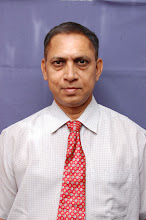In the first part of the chapter 6 lord Krishna
pointed out that Adwaitha Atma Gnanam
alone is the means of liberation. All spiritual seekers will have to come to
Adwaitha gnanam as presented in Vedanta. He
should come to the conclusion that Adwaitha Vastu is no other than myself. I
should know that Brahma satyam Jagat mithyam (mithya meaning names and forms).
Everyone has to come to this knowledge to attain Moksha which is the only means
of attaing Moksha. I can relax only after discovering this fact. This is what
Krishna said in CH 6 up to verse 21. Krishna says that spiritual seekers will
be very few only. Among those only very few will gain the knowledge says
Krishna. This is the only method of attaining the lord. By preparing the mind
you can make this knowledge easy to gain. It is easy for the prepared and
difficult for the unprepared mind. From 22nd verse onwards he says
if you are not ready for Vedanta you need not worry. You can come to Karma yoga
which is saguna bhakti. Krishna says by going to satsanga of knowledgeable
people one can develop values.
Then Uddhava
asks Krishna who is a satpurusha?
Krishna has enumerated 30 virtues of a satpurusha. Those who have and who also value these
virtues are to be associated with Satpurushas. I should start my Bhakthi exercise and make my Bhakthi a refined one.
Artha and Ardhartha bhakthi is unrefined (bhakthi with a purpose) and I use for
finite worldly benefits. They are called Sakama Bhakthi. I have to soon replace Sakama bhakthi with Nishkama Bhakthi. I
gradually reduce family centric prayers and Me centric prayers and start
praying for the whole humanity. This is Sarve Bhavanthu Sukinaka pooja wherein
my Ahamkara (strong attachment to
body mind complex) and Mamakara (strong
attachment to family, possession and position) are gradually reduced. So long my Mamakara and Ahamkara are not
diluted Moksha is far away for me. The notion that I am an individual is
Jiva Bhava. Moksha is replacing Jiva
Bhava by Brahma Bhava. Our destionation is from Jiva Bhava to Brahma Bhava.
Aham Mama centered is Raga and Dvesha (likes and Dislikes). I am interested in
me and my spouse as per my likes and dislikes. I extend this to my children and
grand children and my thoughts are centered on me and my family. This is
reinforcement of Jiva Bhava. I should know that Jiva Bhava and Spiritual wisdom
are diagonally opposite. While strongly retaining the Jiva bhava when I study
the Vedanta this study will be an academic study only. I can’t be liberated as
Vedanta will never bless me. Jiva bhava
and Brahma bhava will never coexist. Finite and infinite cannot coexist. One
of the methods of dilution is converting all our poojas and prayers into
Universal prayer and for the whole humanity. Sarve Jana Sukino Bhavanthu should
be my prayer; Loka samasta sukino bhavanthu. It is difficult but we have to
practice. We require a refined attitude
wherein we include the whole humanity in our prayer. Exercises are
mentioned in Vaidiga karma kanda. The same vaidiga karma becomes unpopular
(doing sandyavandanam, agnihothram nithya karma). Vyasa said it should be
replaced by Agama sastra forms of
devotion in which worship of different deities are involved. Afterwards
Sankaracharya talked about worship and 6 forms of deity. They are Shiva
(saivam), Vishnu (vaishnavam), Shaptam (sakthi, Sri Vidya pooja), Ganapathya
(ganapathi worship), Koumaram (name of Subramanya) and Sowram (surya devatha
where surya is visible). Sankaracharya accepted all of these and said Chathurmasya is a Vedic ritual. If you
don’t know Vaidiga karma it does not matter. It is ok to replace it by Agama
pooja. In uddhava Gita Lord Krishna talks about Vaishnava form of worship. All
these poojas are not for Moksha and meant only for preparing the mind. Thereafter
all people will have to come to Vedanta by doing Shravanam, Mananam and
Nidhithyasanam. One may start with Bhagavad Gita and then Upanishads and
thereafter Brahma sutra. Ultimately we
have to come to the knowledge “Aham Brahma asmi”. We should come to the
conclusion Aham satyam Jagat Mithyam. One who acknowledges this fact is called
a smartha. A Smartha knows that ‘I have to come to Aham Brahma asmi’. Whoever
accepts this fact is called a Smartha. Adi Sankaracharya
is a Smartha. Whoever is following Sankaracharya’s teachings is a Smartha. I
have to purify my mind through Nishkama pooja.
Be blissful
S.Sekar
Contact: sekrajc@yahoo.com

No comments:
Post a Comment